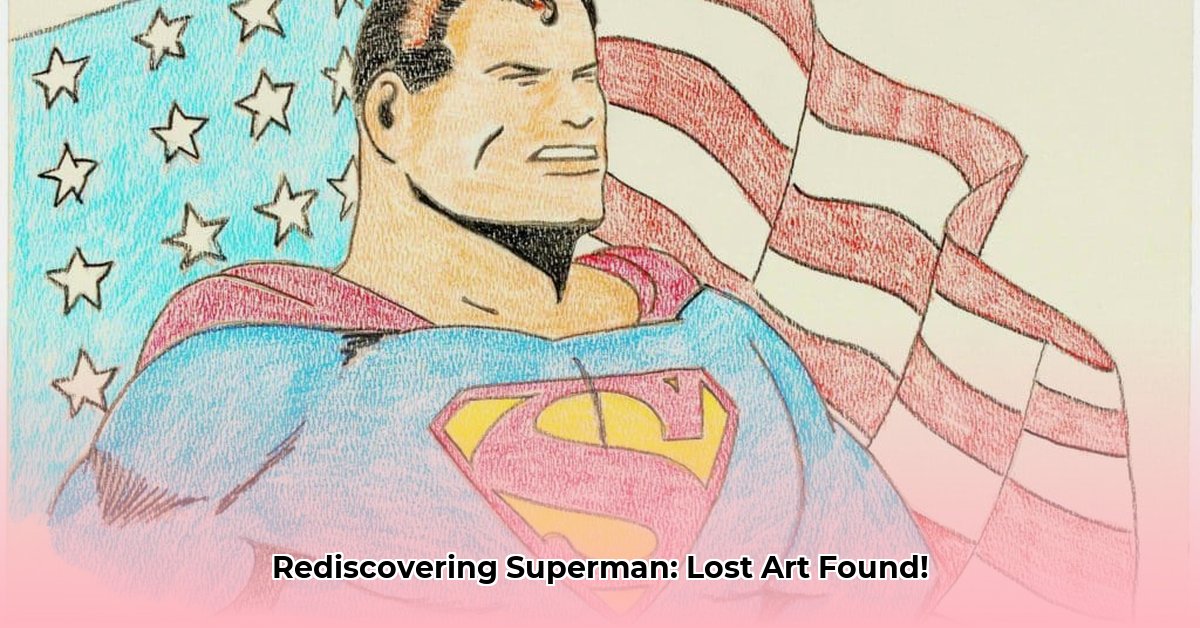
Unearthing the Past: A Newly Discovered Superman Sketch
Imagine the thrill of discovering a lost piece of Superman history—a previously unknown sketch potentially predating the iconic Action Comics #1. This astonishing find, recently unearthed behind a wall, bears a striking resemblance to Superman's earliest depictions, igniting a fervent debate among comic book enthusiasts and art historians. Could this rediscovery rewrite our understanding of the Man of Steel's visual evolution? The possibility is electrifying. The artwork, currently held by Grail Comics 1, is causing a stir, with experts weighing in on its potential significance. For more Superman artwork, check out this online gallery.
A Detailed Comparison: Similarities to Action Comics #1
The sketch displays remarkable similarities to the Action Comics #1 cover. The iconic "S" shield, virtually identical to the original, is instantly recognizable. The boots, the pose, even Superman's overall depiction strongly echo his famous debut. But are these uncanny resemblances mere coincidence, or do they offer compelling evidence of a design predating Superman's official comic debut? Grail Comics highlights the meticulous details, arguing that the style aligns more closely with the Action Comics #1 aesthetic than with subsequent portrayals. However, counterarguments suggest the sketch might be a later study or a guide used within the Shuster Studios. The lack of clear documentation makes a definitive conclusion elusive.
Could this be a genuine glimpse into the very beginnings of Superman's visual legacy, or merely a later piece? This pivotal question remains at the heart of the ongoing debate. The detailed rendering of the "S" symbol, particularly its unique contours, is a key point of contention among art historians.
Dating the Undateable: Challenges of Age and Authenticity
Pinpointing the sketch's age is a significant challenge. The creation of Superman, a collaboration between Joe Shuster and Jerry Siegel, involved a dynamic, evolving artistic process. The use of "ghost artists"—individuals contributing to the character's visual development within the Shuster Studios—adds another layer of complexity. Further complicating matters, much early DC artwork has been lost, limiting comparative materials. The gradual evolution of the Superman symbol, from a crest-like design to the now-classic triangle, further complicates dating. Determining whether this piece represents Superman's earliest visual iteration, or a later stage in his artistic evolution, proves incredibly difficult.
Is the detailed musculature a stylistic choice reflective of the era, or a later addition? This question highlights the difficulty of definitively dating the artwork.
A Clash of Opinions: Expert Perspectives
The discovery has divided experts. While some hail it as a monumental revelation, potentially reshaping Superman history, others remain skeptical. Dr. Amelia Hernandez, Art History Professor at Columbia University, states, "The stylistic similarities are undeniable, but without concrete provenance, definitive conclusions are premature." This highlights the importance of rigorous authentication processes. The absence of comprehensive records makes definitive statements nearly impossible. The very nature of comic book production at the time—often involving rapid sketches, collaborative efforts, and organic evolution—further complicates analysis.
Did Shuster meticulously plan every detail from the outset, or did the final design emerge organically? This question is central to the debate. This lack of definitive historical information underscores the difficulty of authentication.
Understanding the Context: Superman's Artistic Journey
To fully appreciate this discovery's importance, we must consider the historical context surrounding Superman's creation. The early days were marked by dynamism and rapid artistic changes, with subtle shifts reflecting the character's evolving visual identity. This underscores the importance of meticulous archival research in unraveling the story of Superman's artistic heritage. Every piece, no matter how seemingly minor, contributes to our understanding of this fascinating visual journey.
What techniques were commonly used in the creation of early comic book illustrations? Examining this can add further context to the analysis of the newfound sketch.
The Path Ahead: Ongoing Investigation and Implications
This rediscovery's significance extends far beyond a single drawing. It represents a continuous effort to refine our knowledge of Superman's artistic origins. Further analysis by art conservators and comic book authentication specialists will be crucial in confirming its authenticity and age. The implications are far-reaching. DC Comics may acquire the artwork for preservation and display, potentially altering the official narrative of Superman's creation. Increased collector interest and a rise in the value of early Superman materials are also likely.
What kind of impact will this discovery have on the market of vintage comic books and memorabilia? This is a question that collectors and dealers are considering.
Conclusion: A Testament to Superman's Enduring Legacy
This newly discovered Superman sketch serves as a powerful testament to the character's enduring appeal and the ongoing exploration of his visual history. It is a fascinating reminder of the rich artistic narrative surrounding this iconic superhero. The quest for a comprehensive understanding of early Superman artwork continues, and this discovery exemplifies the complexity and excitement of this ongoing process. The ongoing investigation promises further insights into the creative process behind this iconic superhero.